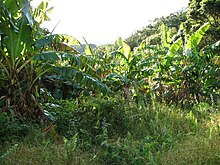| Musa 'Blue Java' | |
|---|---|
 Stands in Maui, Hawaii | |
| Hybrid parentage | Musa acuminata × balbisiana |
| Cultivar group | ABB Group[1] |
| Cultivar | 'Blue Java' |
| Origin | Southeast Asia down to Northern Australia |


The Blue Java (also known as the blue banana, Ice Cream banana, Vanilla Banana, Hawaiian banana, Ney Mannan, Krie, or Cenizo) is a hardy, cold-tolerant banana cultivar known for its sweet aromatic fruit, which is said to have an ice cream-like consistency and flavor reminiscent of vanilla.[2][3] It is native to Southeast Asia and is a hybrid of two species of banana native to Southeast Asia—Musa balbisiana and Musa acuminata.
Taxonomy and nomenclature[edit]
The Blue Java banana is a triploid (ABB)[1] hybrid of the seeded banana Musa balbisiana and Musa acuminata.[4]
Its accepted name is Musa acuminata × balbisiana (ABB Group) 'Blue Java'.
Synonyms include:
- Musa acuminata × balbisiana (ABB Group) 'Ice Cream'
In Hawaii it is known as the 'Ice Cream banana' and in Fiji as the 'Hawaiian banana'. It is also called 'Krie' in the Philippines, 'Kepok Awu' in Indonesia and 'Cenizo' in Central America.
Description[edit]
Blue Java banana trees can grow to a height of 4.5 to 6 metres (15 to 20 ft). They are cold-tolerant and wind-resistant because of their strong pseudostems and root systems. The leaves are silvery green in colour.[2][3]
The fruit bunches are small, bearing seven to nine hands. The fruit are 18 to 23 centimetres (7 to 9 in) in length and exhibit a characteristic silvery blue color when unripe. The fruit turn a pale yellow when ripe, with white creamy flesh. They bloom around 15 to 24 months after planting and can be harvested after 115 to 150 days. The bananas have bumps called "knuckles" due to their passing resemblance to human knuckles.[citation needed]
Uses[edit]
Blue Java bananas are popular bananas that can be eaten fresh or cooked. They are known for their fragrant flavour which has a vanilla-like custard taste.[3]
They are also popular as ornamentals and shade plants for their unusual blue colouration, large size, and tolerance to temperate climates.[5]
Pests and diseases[edit]
Common pests[edit]
Common diseases[edit]
See also[edit]
References[edit]
- ^ a b Daniells, Jeffrey (1995). Illustrated Guide to the Identification of Banana Varieties in the South Pacific. Canberra, Australia: Australian Centre for International Agricultural Research. ISBN 1-86320-138-6.
- ^ a b "BANANA". California Rare Fruit Growers, Inc. 1996. Archived from the original on 17 October 2020. Retrieved 12 January 2011.
- ^ a b c "Musa sp. 'Ice Cream' 'Blue Java' banana". Stokes Tropicals. Archived from the original on 9 April 2010. Retrieved 12 January 2011.
- ^ Michel H. Porche; Prof. Snow Barlow (2002-07-19). "Sorting Musa names". The University of Melbourne. Retrieved 11 January 2011.
- ^ "Musa Blue Java (Ice Cream)". International Banana Society. Retrieved 12 January 2011.

Well, that’s interesting to know that Psilotum nudum are known as whisk ferns. Psilotum nudum is the commoner species of the two. While the P. flaccidum is a rare species and is found in the tropical islands. Both the species are usually epiphytic in habit and grow upon tree ferns. These species may also be terrestrial and grow in humus or in the crevices of the rocks.
View the detailed Guide of Psilotum nudum: Detailed Study Of Psilotum Nudum (Whisk Fern), Classification, Anatomy, Reproduction